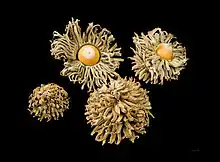Quercus macrolepis
Quercus macrolepis, the Valonia oak,[1] the old name for Quercus ithaburensis subsp. macrolepis.
| Valonia oak | |
|---|---|
 | |
| Example of Q. macrolepis at Tricase, Lecce | |
| Scientific classification | |
| Kingdom: | Plantae |
| Clade: | Tracheophytes |
| Clade: | Angiosperms |
| Clade: | Eudicots |
| Clade: | Rosids |
| Order: | Fagales |
| Family: | Fagaceae |
| Genus: | Quercus |
| Subgenus: | Quercus subg. Quercus |
| Section: | Quercus sect. Cerris |
| Species: | Q. macrolepis |
| Binomial name | |
| Quercus macrolepis | |
| Synonyms | |
| |
Geographical range
It is found in the Balkans, and in the southern and eastern Mediterranean, including the Greek Islands, Turkey, Israel, and Morocco.
Uses

Quercus ithaburensis ssp. macrolepis
The cups, known as valonia, are used for tanning and dyeing as are the unripe acorns called camata or camatina. The ripe acorns are eaten raw or boiled.[2]
See also
References
- Society for Valonia Oak website Archived June 25, 2011, at the Wayback Machine
- Qercus aegilops on food.oregonstate.edu Archived July 21, 2010, at the Wayback Machine
This article is issued from Wikipedia. The text is licensed under Creative Commons - Attribution - Sharealike. Additional terms may apply for the media files.
